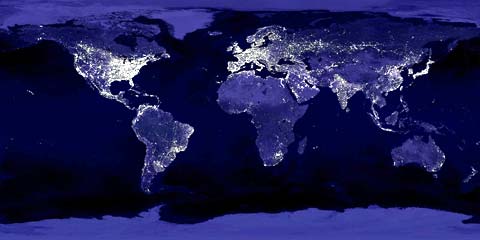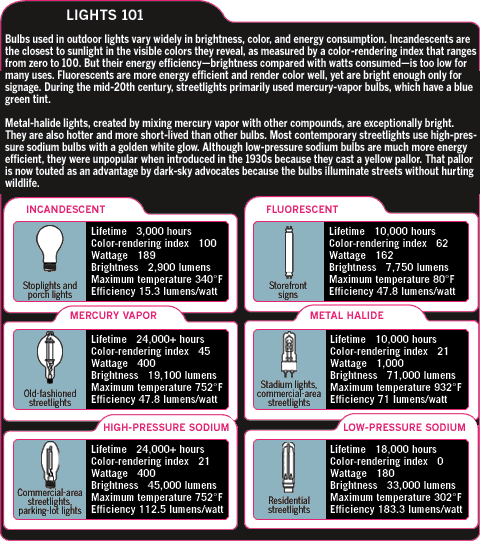DISCOVER Vol. 24 No. 7
(July 2003)
Table of Contents
Turn
Down the Lights
The party's over: when we turn up the lights, nature goes a little
haywire
By Eric Scigliano
On March 31, 1880, the good people of Wabash, Indiana
(population 320), launched a technological revolution. Atop the town's
courthouse dome, they mounted two crossarms with a 3,000-candlepower
carbon-arc bulb at both ends of each. They then fired up a
threshing-machine steam engine to generate electricity, and at 8 p.m.
sharp, flipped a switch. Sparks showered, and Wabash became the first
electrically lit city in the world. "The strange, weird light, exceeded
in power only by the sun, rendered the square as light as midday," one
witness reported. "Men fell on their knees, groans were uttered at the
sight, and many were dumb with amazement. We contemplated the new
wonder of science as lightning brought down from the heavens."
 |
| A photomosaic
released by NASA in 2000 reveals the extent of artificial-light
pollution around the world. The image incorporates data collected by
low-orbiting satellites between October 1994 and March 1995, on nights
when moonlight was low. Italian astronomer Pierantonio Cinzano
estimates that the level of artificial night-sky brightness increases
in Europe and the United States at an annual rate of 5 to 10 percent. Photograph: Data courtesy of Marc Imhoff/NASA GSFC and Christopher Elvidge/NOAA NGDC. Image by Craig Mayhew and Robert Simmon/NASA GSFC. |
A century and a quarter later, electric light turns night into day around the globe. In the first world atlas of artificial night-sky brightness, released in 2001 by the Italian astronomer Pierantonio Cinzano and based on high-resolution satellite data, the heavily developed urban corridors of Japan, Western Europe, and the United States blaze like amusement parks. We flood the heavens with so much artificial light that nearly two-thirds of the world's people can no longer see the Milky Way. On a clear, dark night far from light-polluted skies, roughly 2,500 celestial points of light can be discerned by the naked eye. For people living in the suburbs of New York, that number dwindles to 250; residents of Manhattan are lucky to see 15. Moreover, as the stars fade from view, a growing body of research suggests that excessive exposure to artificial night light can alter basic biological rhythms in animals, change predator-prey relationships, and even trigger deadly hormonal imbalances in humans.
Many creatures are genetically programmed to navigate by the dim glow of the stars and the moon. For them, night lights can be deadly: Michael Mesuren, founder of the Toronto-based Fatal Light Awareness Program, estimates that 100 million songbirds collide with lit buildings in North America each year. Likewise, artificial light is a source of confusion for the nocturnal cousins of butterflies. Entomologist Rod Crawford, of the Burke Museum at the University of Washington, believes that light pollution may be the leading cause, after habitat loss, of the decline of the spectacular giant silk moths that were once a source of summer visual delight. "The farther from lights and altered habitats you get, the more moths you find," he says.
Kenneth Frank, a Philadelphia physician and lepidopterist, says that light-lured moths often miss their brief opportunities to mate, or succumb to light-stalking predators. Bright lights also disrupt migration routes, confining some moth populations to isolated islands of darkness. But Frank concedes that the plight of moths is unlikely to rouse public outcry. "Never argue against something on behalf of moths," he warns. "People will just laugh at you. Talk about ecosystems instead."
And there is plenty to talk about. Just ask Marianne Moore, a limnologist at Wellesley College who studies the life cycles of zooplankton—minute crustaceans and rotifers that rise toward the surface of nearby lakes at night to feed on algae and then descend by day to escape predators. Her research suggests that the sky glow reflected from streetlights prompts the tiny organisms to remain well below the surface. This deprives the zooplankton of nutrients and allows runaway algae to grow, which in turn suffocates other aquatic plant life. At the same time, artificial light appears to wreak havoc on the mating habits of the little lake creatures. "Lunar cues are very important for reproduction," Moore says, and sky glow simulates those cues.
Many people might consider such subtle changes in the environment a small price to pay for brightly lit communities. But new medical data suggest humans are not immune to light pollution. In 2001 the Journal of the National Cancer Institute published two studies that the editors argued revealed "an association between exposure to light at night and breast cancer risk," with "alarming" implications. Scientists at the Fred Hutchinson Cancer Research Center in Seattle interviewed 1,606 women and found a 60 percent greater incidence of breast cancer among those who worked at night; the risk increased with the number of years on the night shift and night hours worked per week. Researchers at Brigham and Women's Hospital in Boston reviewed the health histories of 78,562 nurses and found a lower but still significant correlation: Those with one to 29 years on the night shift showed, on average, an 8 percent increase in breast cancer; those with 30 or more years showed a 36 percent increase.
Other studies have shown that light striking the retina, even during sleep, can reduce production of melatonin, a hormone that helps regulate circadian rhythms. Melatonin also has antioxidant properties, and for some mammals it has been shown to suppress the estrogen estradiol, which is associated with breast cancer. "Light is a drug," says Russel J. Reiter, a neuroendocrinologist at the University of Texas Health Science Center who has researched the disease-preventing properties of melatonin. "By abusing it, we compromise our health."
Not all lights have equal optical and biological effects, even if they shine with equal brightness. Fluorescent bulbs, as well as the metal-halide and high-pressure mercury bulbs often used in stadium lighting, emit a lot of imperceptible ultraviolet light, which is useless for illumination but plays havoc with the detectors used by astronomical observatories. Traditional incandescent bulbs emit a lot of infrared light, which makes them hot and grossly inefficient. All these, as well as the increasingly popular high-pressure sodium bulbs used in street lamps, radiate across a fairly wide spectrum. This makes their light seem more natural and also makes it visible and attractive to moths, birds, and other animals. By contrast, the efficient low-pressure sodium bulbs now used in some street lamps emit only a narrow range of yellow light. This minimizes ecological disruptions, since creatures don't perceive low-pressure sodium as natural light. Moths, for example, don't seem to notice it at all. Some cities near large observatories have switched their streetlights to low-pressure sodium because astronomers can filter it out. But at least one, San Diego, decided to switch back to high-pressure sodium after residents complained that the yellow pall cast by low-pressure sodium bulbs made them uneasy.
One problem with illuminating streets with soft yellow light is that it butts up against a cherished assumption of many officials, businesses, and homeowners: that intense, bright light naturally means more visibility and more safety. Elizabeth Alvarez, the International Dark-Sky Association's associate director, counters with photos of bright streetlights casting deep shadows where bad guys could lurk. "Glare does not help visibility!" she says. "Too much light is blinding."
Alvarez and other dark-sky advocates contend that communities could take a number of other practical steps to reduce the amount of light pollution. They suggest pointing light where it's needed, rather than in the eyes of passersby and at neighbors' windows, by shielding fixtures and replacing rounded lenses that scatter beams to the side with flat-bottomed lights that don't. They also suggest lowering most bulb wattages and eliminating unnecessary lights placed by engineers who never plant one light post when two will do. "Decorative lighting," says Alvarez, "should be used as a paintbrush to highlight details rather than as a wash over the entire building."
Last year, Calgary, Alberta (population 904,987), began putting some of these measures to the test. Engineers downsized the high-pressure sodium lights in several neighborhoods, substituted 100-watt for 200-watt bulbs and 150-watters for 250s, and installed flat lenses that focus the light downward. Streetlighting coordinator Barry Poon says elderly citizens howled that less lighting would boost crime. "But police told us there's no correlation between light levels and crime. Breaking and enterings actually occur in daytime when people aren't in." The results agreed: The crime rate in the areas with the new lights went unchanged. Now, Poon reports, "I'd say we get 10 positive responses for every negative one." Budget watchers were also pleased; the conversion, which will cost 4.5 million U.S. dollars, will save $1.3 million in electricity each year.
Ironically, the prospect of saving money—about $800 a year—was what prompted the thrifty town fathers of Wabash to replace their glowing gaslights with glaring electrics 123 years ago. These days, staff scientist Evan Mills of the U.S. Department of Energy's Lawrence Berkeley National Laboratory calculates that people around the world use more than 2.2 quadrillion watt-hours of electricity every year for lighting, at a cost of about $200 billion. Mills estimates that this consumption could be cut in half with more efficient fixtures, better design, and appropriate light levels. That might also double our delight in the natural wonders of the night.

Illustration by Don Foley
RELATED WEB SITES:
Learn more about the image that appears on pages 60 and 61 at earthobservatory.nasa.gov/Study/ Lights/lights_2.html and at antwrp.gsfc.nasa.gov/apod/ap001127.html. For a more technical explanation of the image, see sedac.ciesin.org/plue/gpw/presentations/ ChrisElvidge/nightCD/world95.html.
View Pierantonio Cinzano's World Atlas of the Artificial Night Sky Brightness at www.lightpollution.it/worldatlas/pages/fig1.htm.
The Light Pollution Science and Technology Institute Web site explains details visible in Cinzano's atlas, offers some basic information about using satellites to capture images of the night sky, and has links to other night sky research organizations: www.lightpollution.it/dmsp/index.html.
Visit the Web site of the International Dark-Sky Association, where you learn the basics about light pollution and its effects on the environment and the study of astronomy. This grassroots education group also offers plenty of links to other useful sites: www.darksky.org.
Read more about the EnviroSmart Streetlights Project in Calgary at www.calgary.ca (type "streetlights" in the search box).
At the Web site of the Astrophysics Institute of the Canary Islands, learn more about light pollution and which light fixtures and bulbs can help address the problem: www.iac.es/proyect/otpc/eng.htm.
A very brief history of streetlighting in America appears on the Smithsonian Institution's site: americanhistory.si.edu/csr/lightproject/ ind_m.htm.
Learn more about the biological effects of light pollution in the Science News article "Deprived of Darkness: The Unnatural Ecology of Artificial Light at Night": www.celfosc.org/biblio/bio/ 020420sciweek.htm.
© Copyright 2003 The Walt Disney Company. Back to Homepage.